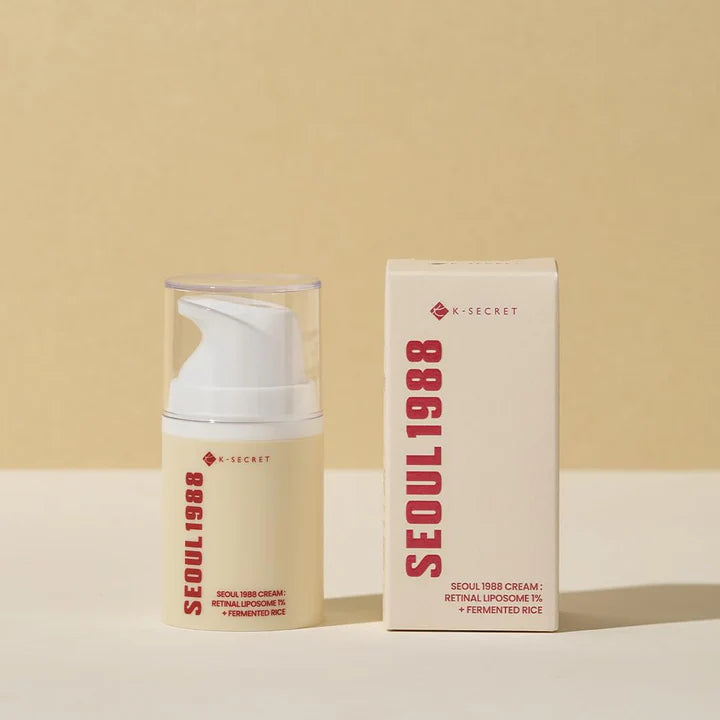





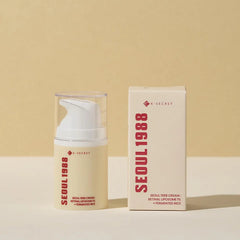
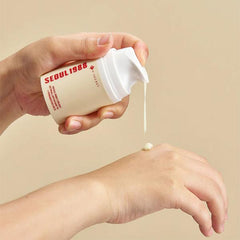
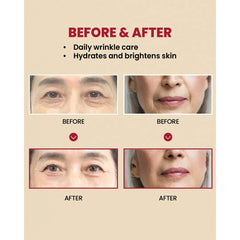
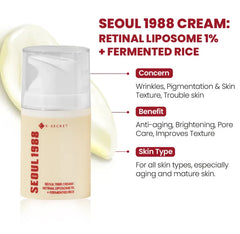


K-Secret - Seoul 1988 Retinal Liposome 1% + Fermented Rice Cream 50ml
- Rs. 5,850
- Rs. 5,850
- Unit price
- per
Free Returns
Shipping Time

Vendor: Makeup Stash Pakistan
K-Secret - Seoul 1988 Retinal Liposome 1% + Fermented Rice Cream 50ml






Vendor: Makeup Stash Pakistan
K-Secret - Seoul 1988 Retinal Liposome 1% + Fermented Rice Cream 50ml
Description
xK‑Secret Seoul 1988 Cream: Retinal Liposome 1% + Fermented Rice (50 ml) — what it is, what’s inside, how it works, benefits, how to use, pros/cons, etc. If you need a shorter version or a version in Urdu/Persian or for ads, I can do that too.
What It Is
The K‑Secret Seoul 1988 Cream: Retinal Liposome 1% + Fermented Rice is a Korean anti‑ageing facial cream combining retinal (a vitamin A derivative) encapsulated in liposomes (1% “Retinal Liposome”) plus fermented rice (along with other ferments), botanical extracts, peptides, and antioxidant actives. It comes in a 50 ml jar/size.
This is marketed for improving fine lines & wrinkles, brightening skin tone, improving skin texture, helping skin elasticity and firmness, while offering hydration and anti‑oxidant protection.
Key Ingredients & What They Do
Here are the major actives and supporting ingredients, and how each contributes:
| Ingredient | Role / Benefit |
|---|---|
| Retinal (100 ppm / under “Retinal Liposome 1%”) | Retinal (also known as retinaldehyde) is a vitamin A derivative. It promotes cell turnover, helps with collagen production, smooths out fine lines and wrinkles, improves texture, and has anti‑ageing effects. Encapsulation in liposomes helps with controlled release and can reduce irritation / irritation potential. |
| Fermented Rice (Lactobacillus/Rice Ferment; ~1,000 ppm) | Fermented rice is known for brightening effects, helping to even out skin tone, plus it can have mild exfoliating, moisturizing, and antioxidant effects. Fermentation often increases bioavailability of certain compounds, making them more effective. |
| Other Ferments & Botanical Root Extracts — e.g. Lactobacillus/Panax Ginseng Root Ferment Filtrate; Saccharomyces/Coix Lacryma‑Jobi Seed Ferment; more root extracts etc. | These provide antioxidant protection, soothing of the skin, helping with overall skin health, reduce inflammation, support barrier function. Ginseng ferments also improve circulation, skin radiance. |
| Niacinamide | Helps with barrier repair, reducing visible pores, brightening, improving texture, reducing irritation. Widely used in “brightening / anti‑ageing” formulations. |
| Peptides (three types: SH‑Oligopeptide‑1, SH‑Oligopeptide‑2, SH‑Polypeptide‑1) | Peptides help to stimulate collagen and elastin production, promoting firming of the skin, improved elasticity, reducing sagging or fine lines. They also help in repair and renewal. |
| Bakuchiol | A plant‑derived alternative/complement to retinol/retinal; provides many similar benefits (antioxidant, anti‐ageing, collagen support) with often lesser irritation. Enhances the overall retinoid effect while moderating harshness. |
| Vitamin C derivative + Vitamin E & Other Antioxidants | To protect against free radical damage (from UV, pollution), brighten skin tone, help reduce pigmentation. The presence of both C derivatives and Vitamin E help in stabilizing antioxidant systems. |
| Moisturizers & Emollients / Barrier Support Agents — e.g. Macadamia seed oil, cholesterol, ester lipids, glycerin, etc. | These ensure hydration, restore or support skin’s barrier, reduce dryness / peeling that can come from retinal use, improve skin smoothness. |
Strength & Specifics
-
The cream is labelled “1% Retinal Liposome.” In practice that means the retinal (in liposomal form) is formulated at that level. A more precise number for the actual retinal might be lower (often the percentage refers to “liposome” mixture rather than pure retinal concentration). The ingredient list indicates “Retinal (100 ppm)” which is about 0.01% in terms of pure retinal.
-
The fermented rice component is about 1,000 ppm (parts per million) of the rice ferment, which contributes to its brightening / texture improving functions.
What It Feels Like / Texture & Sensory
-
Texture is creamy, richer than a serum but not very heavy or greasy; it absorbs fairly quickly. Many reviews say it is smooth, non‑sticky, and leaves a comfortable finish.
-
The cream provides moisture and a rich emollient feel; because of its compound of lipids, oils, ferments, etc., it feels nourishing.
-
Scent/fragrance: It appears relatively mild; some versions do not emphasize strong fragrance, but as with many Korean creams, there may be mild natural scent from botanical extracts/ferments. (If you have fragrance sensitivity, patch test recommended.)
Benefits / What It Can Do
When used properly and over time, you can expect the following benefits:
-
Reducing Fine Lines & Wrinkles — Retinal helps speed up skin turnover, stimulate collagen, smooth out superficial wrinkles.
-
Improved Skin Texture — Rough patches, dullness, unevenness in texture should become smoother due to both retinal and fermented agents.
-
Brightening & More Even Skin Tone — Fermented rice, vitamin C, niacinamide help reduce pigmentation, dark spots, uneven tone; antioxidant effect helps with overall clarity.
-
Enhanced Elasticity & Firmness — Peptides + retinoid + botanical root ferments work together to bolster skin’s structural support.
-
Antioxidant Protection — Botanical root extracts + vitamins + ferments combat oxidative damage from environment or UV.
-
Hydration & Barrier Strength — Emollients, lipids, cholesterol, glycerin, plus ferments/niacinamide help maintain moisture, reduce dryness, flaking; strengthen the barrier so subsequent irritants are less aggressive.
Suitability & Skin Types
-
Suitable for many skin types — normal, combination, dry, even somewhat mature or early signs of ageing skin. Several sources say “especially ageing / mature skin.”
-
Also for those wanting retinal benefits but not ready for very strong retinoids. Because this is a moderately mild version (liposomal, plus supportive ingredients), it can be gentler if used correctly.
-
However, less ideal for skin that is extremely sensitive, or currently inflamed (active acne with inflammation, eczema flares, broken skin) until skin barrier is stabilized. Pregnant or breastfeeding individuals should check professional guidance, since vitamin A derivatives often have contra‑indications.
Possible Side Effects / What to Expect
-
When first using, you may experience mild sensations: slight tingling, mild dryness, peeling or flaking, especially around nose or mouth or wherever skin is thinner.
-
Redness or sensitivity may occur. The cream’s formulation tries to moderate that, but retinoids inherently carry that potential.
-
Increased sun sensitivity: use of retinal (or any vitamin A derivative) increases the skin’s vulnerability to UV; sunscreen is a must.
-
Overuse or using together with strong exfoliants / acids without caution may cause barrier damage, peeling, irritation.
How To Use for Best Effect
To get good results and minimize irritation:
-
Patch test first (behind ear, jawline) for 24‑48 hours before full face application.
-
Start slowly — begin usage 2‑3 nights per week, gradually increasing frequency as skin tolerates. If no irritation, increase to nightly or every other night.
-
Evening use is preferred for products with retinal. Use after cleansing (and toning or essence if you use), possibly after lighter serums, then this cream. If your skin is dry or sensitive, buffer with a moisturizer (apply moisturizer first, then the retinal cream, or mix with moisturizer).
-
Sun protection daily — in the morning use a broad‑spectrum sunscreen (SPF 30‑50) to protect against UV damage.
-
Do not combine with aggressive exfoliants or other strong retinoids at first, to avoid overstimulation. Use alternate cells or nights, or only when skin is adapted.
-
Moisturize — even with this cream, ensure your skin gets good hydration (serums, hydrating toner, occlusive or barrier‑support creams) to reduce dryness or peeling.
Expected Timeline of Results
Here is what many users may notice over time with regular use:
| Time | What You Might See |
|---|---|
| First 1‑2 weeks | Possible mild dryness / flaking; some skin may feel tight. Possibly improved hydration due to moisture from cream. Perhaps slight glow / smoother surface texture starting. |
| Weeks 3‑6 | More obvious smoothing of fine lines; texture becomes more even; skin looks brighter; tone becoming more balanced; less dullness. |
| Weeks 6‑10 | Further firming; deeper lines may start reducing; elasticity improving; dark spots or pigmentation patches may begin fading. Skin barrier should be stronger, irritation less frequent. |
| 3+ months | Significant visible improvements: better firmness, more youthful appearance, more resilient skin, more refined pores/texture, more radiant, even tone. |
Pros vs Potential Cons
Pros:
-
Combines retinal with gentler, nourishing ferments & botanicals, peptides, antioxidants — multifaceted formulation.
-
Moisturizing / barrier‑supportive, helping reduce common retinoid irritation.
-
Brightening + anti‑ageing + texture improvement in one product.
-
Rich but relatively comfortable texture, non‑sticky, good finish.
-
Suitable for people who want retinoid effects but moderate strength; good “entry retinoid/retinal” cream.
Cons / Things to Watch:
-
Even with mild formulation, some irritation/adjustment period likely.
-
Higher price vs simpler creams; cost per use may be significant.
-
Need for strict sun protection.
-
Might feel heavy for very oily skin, especially in humid climates. Could lead to pilling if combined with too many thick layers.
-
If overused or used with too many other active ingredients, risk of over exfoliation or barrier breakdown.
Ingredient & Formulation Details & Highlights
Here are some more detailed things worth noting:
-
Ingredient list includes water, glycerin, butylene glycol, niacinamide, etc., with “Retinal (100 ppm)” listed.
-
Liposome encapsulation of Retinal helps with delivery and mitigates irritation.
-
Fermented ingredients: multiple different ferment filtrates, including rice, ginseng root, soy‑bean, etc., which help with skin repair, moisture, also mild antioxidant benefit.
-
Backup antioxidants: vitamin C derivative (3‑O‑Ethyl Ascorbic Acid), tocopherol (vitamin E), botanical root extracts etc.
How It Compares with Other Products / What Makes It Special
-
Compared with pure retinol creams: retinal is more potent / effective in fewer conversion steps, may yield faster results (though risk of irritation is there, but liposomal form and supporting ingredients aim to reduce that).
-
Compared with “retinoid‑only” formulations, this cream offers multiple beneficial complementary actives (ferments, peptides, antioxidants) which both increase efficacy and possibly reduce side effects.
-
Compared to lighter creams / serums: thickness and moisture content is greater, so better for dry or mature skin; possibly heavy for oily or humid environments.
-
Among Korean skincare offerings, this sits in the mid‑to‑upper range of anti‑ageing creams with modern actives + fermentation, which is increasingly popular.
Who It’s Best For
This cream is ideal if you:
-
Are showing early to moderate signs of ageing: fine lines, mild sagging, loss of firmness or elasticity.
-
Have skin that tolerates vitamin A derivatives somewhat, or you want to transition into retinoids.
-
Want brightening or more even skin tone, and improved texture.
-
Prefer formulations with ferments, botanical extracts, peptides, not just a single strong active.
-
Need hydration & barrier support in addition to anti‑ageing.
It is less ideal if:
-
Your skin is very sensitive, inflamed, or has compromised barrier at the moment.
-
You are pregnant / breastfeeding (check medical advice).
-
You are in very hot/humid climates and/oily skin where heavy creams cause congestion.
-
You’re already using stronger retinoids and need something more aggressive (this is more of a gentler / intermediate formula).
How to Incorporate Into Your Routine
Here’s a sample routine showing how to use this cream:
-
Evening Routine (Start Phase): Cleanser → Toner → (optional light hydrating serum) → Seoul 1988 Cream: Retinal Liposome 1% + Fermented Rice (2‑3 nights per week to start) → Moisturizer (if needed)
-
Morning: Cleanser → Toner / Hydrating mist → Moisturizer → Sunscreen (very important)
If you have other active ingredients (exfoliating acids, Vitamin C serums, etc.), avoid using too many at once. For example, avoid using strong AHA/BHA same night as retinal until skin is used to it.
Related Products
- Choosing a selection results in a full page refresh.




